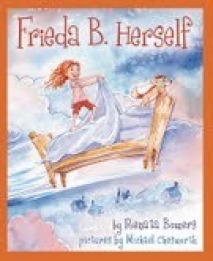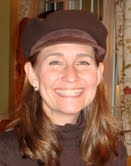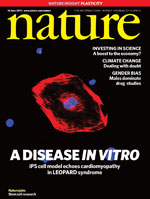 Special Gifts = An Extraordinary Story You are the parent of an extraordinary child. Of course, you already know that.However, words like “special” mean something different to you than they do to some. There are days when it would seem that you are the only one who understands the difference between “special” and extraordinary. How do you rise above the communication challenges and convey to your child that they were created to live a wonderful life? I wrote my first children’s book, Frieda B. Herself (www.friedab.com) as a springboard to a discussion with children (and adults) - to inspire them to dream their dreams big and get in touch with that which makes them unique and wonderful. I go to schools and speak with children often. It’s what I believe I was created to do. Here is a bit of what I say. I hope that it is helpful to you as you encourage your child to seek out and live out the things that bring them joy. You – yes, you – have a story inside you. A really special story that only you can tell. And you’re meant to tell it your whole life long. But. You have to believe that you have a story in order to tell it. Now, in order to find your story and tell it, you must dream your dreams big and believe they can be. . Here’s how it works. First of all, you must know: You have special gifts tucked away in your heart and your mind and your arms and your legs and your eyes and maybe even your feet. Gifts that make you who you are. Like a runner, a hugger, a reader, a joke-teller, an explorer, a baker, a builder, a painter. And your combination of gifts is unlike anyone else’s. That special combination is the key to your story. So how do you begin to figure out and tell your story? Simple. Listen to – and follow – and dream about – what you love. With all your heart. Dream big, about who you can be, what you can do, that will make the world a better, brighter place. And don’t – don’t -- worry about what other kids love that you don’t. They’re them. You’re you. And the best part of all is that your gifts and their gifts combined can tell an even more wonderful, bigger, better story, together. So don’t be who you aren’t. Be who you are. Love what you’re meant to love, do what you’re meant to do. Do this, and you, my dear and wonderful friend, will be well on your way to blessing the world with the beautiful story you carry inside you. Oh, it's true. I believe in you. Dream Your Dreams Big and Believe They Can Be, Renata  Renata is the author of “Frieda B. Herself.” Her website is www.friedab.com..
1 Comment
Phase 2 Results of the Autism Genome Project have recently been Published in the journal, Nature. The Autism Genome Project (AGP) (www.autismgenome.org) is an international autism genetics research consortium co-funded by Autism Speaks, the Medical Research Council, Canadian Institutes of Health Research, Health Research Board (Ireland), Genome Canada, the Hilibrand Foundation and Autistica. They have been looking at genotyping data collected from 1,000 individuals with autism spectrum disorder (ASD) and 1,300 without ASD, and have reported that individuals with autism tend to carry more submicroscopic insertions and deletions called copy number variants (CNV) in their genome than controls, some of which appeared to be inherited, where others are new (were not found in parents) New genes were identified, some of which are related to connection in the brain (synapses) and others to the numbers and use of cell structures in the brain, and connections between cells; areas which could possibly affect future treatment approaches. Each variant may only account for a small fraction of the cases, but together, they are starting to account for a greater percentage of individuals in the autism community. The overlap between autism susceptibility genes and genes previously implicated in intellectual disabilities further supports the hypothesis that at least some genetic risk factors are shared by different psychiatric developmental disabilities. Finally, identification of these biological pathways points to new avenues of scientific investigation, as well as potential targets for the development of new treatments. Andy Shih, Ph.D., Autism Speaks vice president for scientific affairs, explains that “Piece by piece, we are discovering genetic mutations that can cause autism. These findings will provide answers for families about what contributed to their autism. Furthermore, as we have learned from examples involving other genetic risk factors of autism (e.g., Fragile X, Rett, TSC), these genetic findings help us understand the underlying biology of autism, which can lead to the development of novel treatments.” For a copy of the direct article, please visit the following link: http://www.nature.com/nature/journal/vaop/ncurrent/pdf/nature09146.pdf The AGP consists of 120 scientists from more than 60 institutions representing 11 countries who formed a first-of-its-kind autism genetics consortium. The AGP began in 2002 when researchers from around the world decided to come together and share their samples, data, and expertise to facilitate the identification of autism susceptibility genes. This continuing collaboration and its unique scientific assets (e.g., large sample set and multidisciplinary expertise) created scientific opportunities that otherwise would not exist. The AGP is well positioned to build on these extraordinary assets as the field of autism genetics further investigates rare variants, requiring larger sample sets to identify more CNV. Additional support for Phase 2 of the AGP was provided by the National Institutes of Health. The first phase of the AGP, the assembly of the largest-ever autism DNA collection and whole genome linkage scan, was funded by Autism Speaks and the National Institutes of Health and completed in 2007. Casey Burgess, 2010 |
AuthorCasey Burgess has a B.Sc.in Psychology, an M.A. in Education (Curriculum and Instruction), and a Ph.D. in progress in Education (Cognition and Learning). She has 20 years experience with direct service, curriculum development, workshop facilitation, and supervisory experience supporting children who have Autism Spectrum Disorders, and their families. She currently frames her work using a developmental, relationship-based, self-regulation lens. Archives
June 2021
Categories |

 RSS Feed
RSS Feed